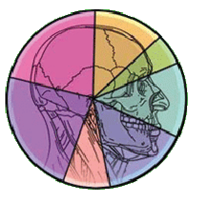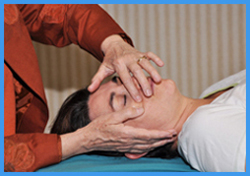About Facilitated Pathways Intervention (FPI) Therapy
 What is Facilitated Pathways Intervention?
What is Facilitated Pathways Intervention?
FPI is a gentle manual therapy – a physical treatment on the head and neck that reduces pain and improves mobility throughout the body. FPI releases neuromuscular tension by quieting hyperactive nerves, which relieves pain and other dysfunctions in ‘connective tissues’ like muscles and fascia. The therapy can be focused to relieve specific joint or muscle problems, or directed toward more general (systemic) pain relief. FPI can also create a new level of balance in reflexes and correct patterns of overuse to improve functional strength and sports performance.
 Is this a new therapy?
Is this a new therapy?
FPI is an innovative therapy developed in the late 1990s by Flo Barber-Hancock. It is part of the exciting new paradigm – CranioSomatics – developed by Flo Barber and Dr.G. Dallas Hancock. CranioSomatics is a new way of looking holistically at relationships between the head, the cranial nerves, the muscles and other soft tissue throughout the body. The FPI concepts and techniques are unique. They are not part of nor developed from any other existing therapy. The positive results achieved by FPI (when other techniques have not been successful) may be attributed to the CranioSomatic paradigm
on which FPI is founded.
What does FPI do?
- It reduces or eliminates pain and muscle tension, and increases range-ofmotion
in restricted joints.
- It provides long-term improvements, which are usually maintained simply by the
individual’s routine activities of daily living.
- It appears to be helpful in reducing chronic tension and discomfort that is typical
of cerebral palsy, stroke, and some other neurological conditions. It may also
assist recovery of voluntary control of muscles in some of these conditions,
depending on the severity of symptoms and when treatment is begun.
What types of problems respond to Facilitated Pathways Intervention?
Common back-aches, ‘tennis elbow’, headaches, Cerebral Palsy, closed head traumas, TMJ dysfunctions, Stroke, accident injuries, Repetitive Motion or Cumulative Trauma Disorders (RMD / CTD), chronic pain, torticollis, allergies / sensitivities, and many other complaints have responded favorably to FPI therapy. Some trigeminal neuralgias (including facial tics), Bell’s Palsy symptoms, and eye-movement difficulties (sudden onset double-vision) have also responded well. Ms. Barber-Hancock would like to work with individuals affected by electrical trauma (including lightning strikes). She welcomes new challenges, and would particularly like to evaluate the effectiveness of FPI with Phantom Limb Pain.
Is this treatment suitable for children?
Yes. Children usually respond very well. The therapy is gentle, and also tends to be very soothing, so most children like it. Their bodies generally accept change quickly and easily, so the course of treatment may be quite short, depending on the condition. It is effective for a variety of childhood problems, including sports injuries. Children with significant chronic problems – like cerebral palsy or injuries from a serious accident – will typically need longer treatment, but progress is still usually evident from visit to visit. Ms.Barber-Hancock would like to do more therapy with young children diagnosed with Cerebral Palsy.
Can FPI therapy improve performance in athletic & sports activities?
Yes! Muscles will have more balanced movement and more strength in any position or movement, regardless of the preceding movement. If you are interested in enhancing your performance with a body that functions more efficiently, this will be an exciting therapy for you. FPI makes long-term changes in basic ‘reflex’ patterns by equalizing muscle function, which is typically reflected in greater accuracy, increased consistency, and better scores. FPI is also very effective in releasing the chronic pain that often comes with repetitive movements as one perfects technique in a competitive sport.
How is Facilitated Pathways Intervention different than existing therapies that address these same problems?
FPI is based on the CranioSomatic paradigm. Most rehabilitative and therapeutic modalities work directly on the joints, muscles and other soft tissues that are involved with the pain or mobility problem, in an attempt to change the tissue. Sometimes these treatments are stressful or painful for the patient. FPI treatment is performed on arelated area on the head, neck or collarbone (areas innervated by the cranial nerves), and reduces tension in the problem area by indirectly affecting the nerves and other soft tissues that have been perpetuating the tension and/or pain. There is usually little or no discomfort for the patient receiving this therapy. FPI requires little effort by the patient and is often very relaxing, so it can be effective even for patients who are weak or have low energy levels.
How can working on my head reduce my back (elbow, knee, etc.) pain?
The head is the command center for posture, balance and control of movement. In the most simple words, it goes back to that old song: Leg bone connected to the hip-bone; hip-bone connected to the back-bone; back-bone connected to the neck-bone, neckbone connected to the head-bone. . . . You get the idea. If the ‘joints’ (articulations) and connective tissues (muscles, fascia, tendons, etc.) of your head have more optimal function, then your neck, back, and everything else in your body – particularly your muscles and joints – also have the opportunity to function better.
How long has Facilitated Pathways therapy been in use?
The FPI techniques have been in regular clinical use since the late 1990’s by Flo Barber-Hancock, the developer of this therapy, at Hancock Holistic Clinic in Tampa, Florida, where hundreds of patients have been treated using these techniques. The Facilitated Pathways techniques have been taught to healthcare practitioners in the US,
Canada, Europe, and Costa Rica.
How does Facilitated Pathways Intervention (FPI) work?
The physiological mechanisms that produce the FPI benefits are not yet clear. It seems, however, that the gentle FPI techniques on the head, face and neck (areas served by cervical nerves) are producing a quieting effect on hyper-irritated nerves of both the central and peripheral nervous systems. Reducing the hyperactivity of nerves reduces chronic tension in tight muscles and reduces the body’s over-all stress level. These reductions in neuromuscular tension and stress can also facilitate the movement of lymphatic fluid and blood. These and other benefits are believed to contribute to the reduction or elimination of pain.
How is the therapy performed?
Working as a team, the therapist and patient choose an area that needs treatment – a joint, limb, or muscle group that has pain or a functional / mobility problem. Facilitated Pathways therapy can be performed with the patient sitting, standing or lying down. The position used often relates to the problem being addressed. (For example, a golfer might assume a golfing pose; another person might need seated treatment for gripping a cup or a tool.) Patients usually remain fully clothed.
The appropriate ‘Treatment Zone’ is identified (the treatment zones are always on the head, neck or collarbone). The therapist uses gentle strokes with his/her fingers on the superficial soft tissues in the treatment zone to bring about neurological changes that relieve pain and restore function to the chosen joint or muscle area. The therapist may also perform some joint mobilizations and range of motion movements of the extremities as part of the therapy session. Treatment procedures are always geared to the age, needs and ability of the patient.
How often do I have to come for therapy?
There is no set formula. It depends on several factors, including the severity of your symptoms, how long you have had them, and what you consider a successful resolution. It can be as short as 4 – 5 treatments. Typical patients come 2- 4 times a month to address pain or dysfunction that is significantly limiting their activities and quality of life. The frequency of treatment is reduced as you are able to perform your usual activities
without limitations or pain.
How long will results last?
The results are usually long lasting – months to years. Most people can continue (or resume) their favorite activities without getting back into pain or restrictions. Patients who have ‘graduated’ from frequent treatment may chose to come 3 or 4 times a year for a half-hour ‘tune-up’ to keep their body functioning well. Having a pain-free body is nice. People get used to it. They like it. They want to be sure it stays that way.
Where is Facilitated Pathways Intervention available?
Flo Barber, the developer of FPI, has regular clinic hours at Hancock Holistic Clinic, in Tampa, Florida. FPI practitioners are in other states and several foreign countries. We are encouraging our practitioners to link with this website. (Find a Practitioner)
Can I continue treatment with my current massage therapist, chiropractor, physical therapist, etc?
Yes, the FPI therapy enhances the benefits of other modalities. Progress in physical therapy is usually faster, and may also be easier.
Where can I learn more about FPI and CranioSomatics?
See our ‘Resources’ page, or Contact Us if you need specific information.
Will my insurance pay for this treatment?
FPI is a manual therapy, and as such is covered or reimbursed by some insurance policies in some situations (for example, after an insured accident or fall). Coverage may depend on the healthcare license of the person providing treatment. Insurance policies and conditions vary widely, so there is no single or simple answer. Locate and contact an FPI therapy provider, then call your insurance agent to verify your coverage.
